Birds of prey are fascinating birds with some similar features. They are clearly apex predators and their prowess has made them some of the most fearsome flyers in history. There is a reason that flags, sports teams, and currencies all sport these majestic birds as a sign of freedom and power! Two of the most common birds of prey someone is likely to encounter are the peregrine falcon and the osprey. Due to their similarities, they are often confused with one another. Today, we are going to take a look at these birds and discover what makes them special. Let’s explore the differences between the peregrine falcon vs the osprey.
Comparing a Peregrine Falcon and an Osprey
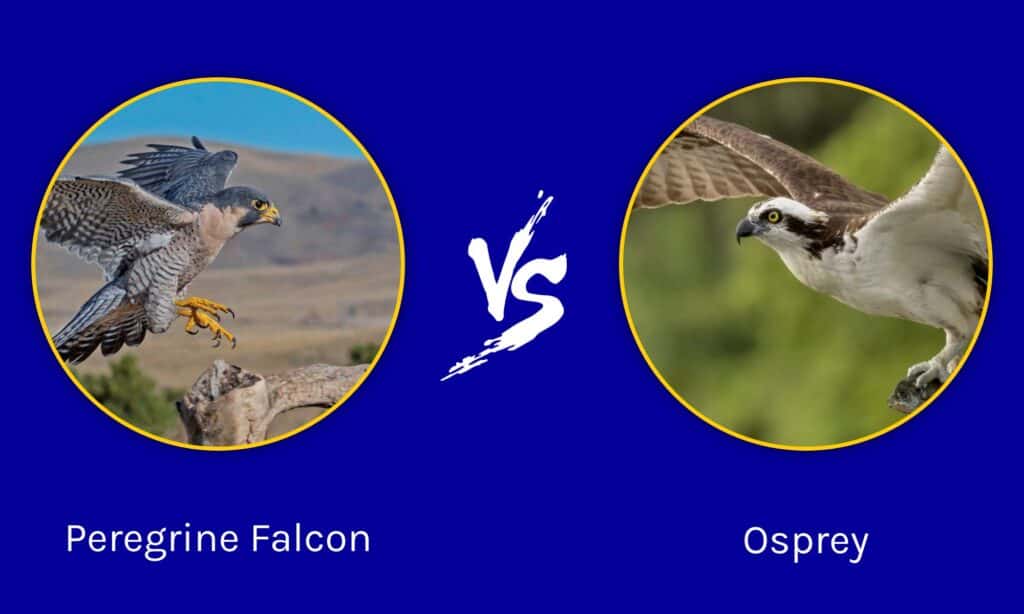
| Peregrine falcon | Osprey | |
|---|---|---|
| Taxonomy | Family: Falconidae Species: Falco peregrinus | Family: Pandionidae Species: Pandion haliaetus |
| Appearance | Dark blue or slate gray bodies. Barred white bellies with a bright yellow beak, eyesockets, and talons. | Brown back and wings. White belly and head. White talons and bright yellow eyes. |
| Wingspan | 2.4-3.9 feet | 4-6 feet |
| Distribution | Nearly everywhere on earth. | Nearly everywhere on earth. |
| Top Speed | Recorded diving at 240 mph. | 80 mph. |
| Prey | Varies, but mostly medium-sized birds. | Varies, but mostly fish. |
The Key Differences Between a Peregrine Falcon and an Osprey
The key differences between a peregrine falcon and an osprey are taxonomy, appearance, wingspan, distribution, top speed, and prey.
Peregrine falcons and ospreys are two of the most common and widespread raptors across the world. These birds of prey are incredible hunters designed for aerial attacks on their prey, but there are most certainly a few things that make them different from one another.
Although both birds are raptors, they are members of distinctly different taxonomical groups (scientific groupings of animals). Peregrines are falcons and belong to Falconidae, while ospreys are unique members of the Pandionidae family. Ospreys are related to hawks, eagles, and kites, whereas falcons aren’t.
Both birds are extremely widespread, with the peregrine and the osprey holding the number one and number two position of “most widespread raptor in the world,” respectively. Within their ranges, they occasionally overlap. Despite this, the two birds have distinct prey preferences and rarely compete.
Let’s take a look at peregrine falcons vs ospreys in some more detail below!
Peregrine Falcon vs Osprey: Taxonomy
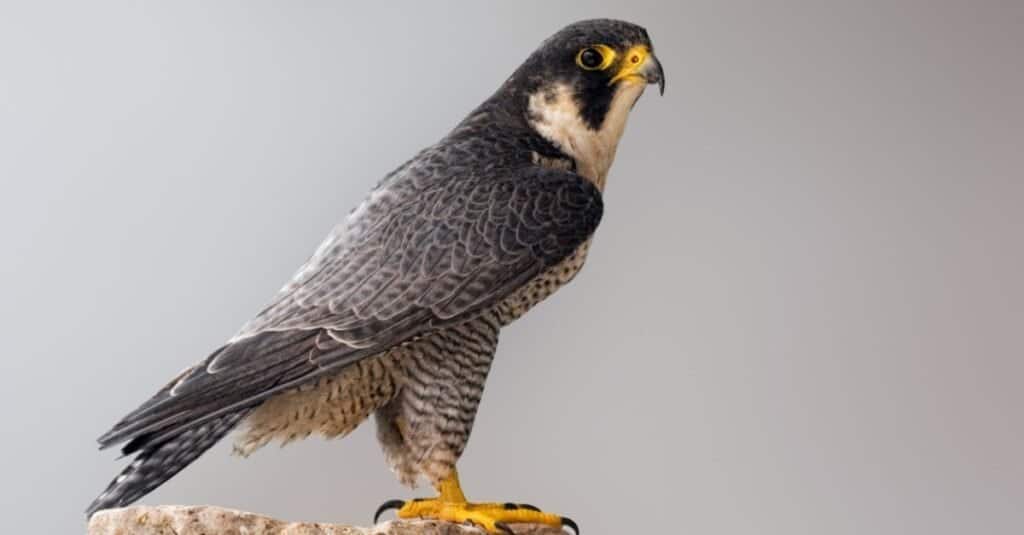
The peregrine falcon is a member of the Falconidae family.
©iStock.com/hstiver
Peregrine falcons are members of the Falconidae family, along with other falcons. While they are quite similar to hawks, eagles, kites, and ospreys as birds of prey, they aren’t classified in that large group (known as Accipitriformes). DNA testing has instead shown that falcons are related to parrots and through the process of convergent evolution have similarities with other birds of prey.
Ospreys are unique in the fact that they are the only members of the Pandion genus and Pandionidae family. They are occasionally split into two species, the eastern osprey and the western osprey, but the differences between the two are debated. There are clear visual differences, but many argue they aren’t distinct enough to merit their own taxonomical grouping.
Peregrine Falcon vs Osprey: Appearance
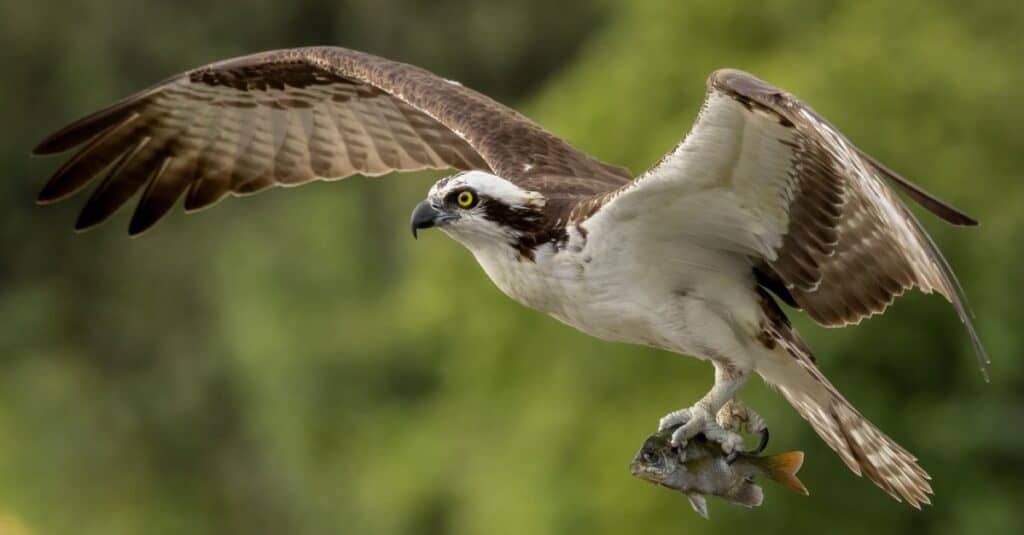
Ospreys have brown backs, wings, and white bellies.
©iStock.com/Harry Collins
Peregrine falcons have blue-black or slate gray bodies and white bellies. Their bellies are barred, usually with blue-black, rust, or brown markings starting about a quarter of the way down. Additionally, peregrines have yellow talons, eyesockets, and beaks, although their eyes are usually dark brown or black.
Ospreys have brown wings and backs, often with a brown patch on their chest. Their bellies, neck, and heads are white, although they have a brown mask reaching from their back and covering their eyes on both sides. They usually have bright yellow eyes, white or gray talons, and a black beak.
Peregrine Falcon vs Osprey: Wingspan
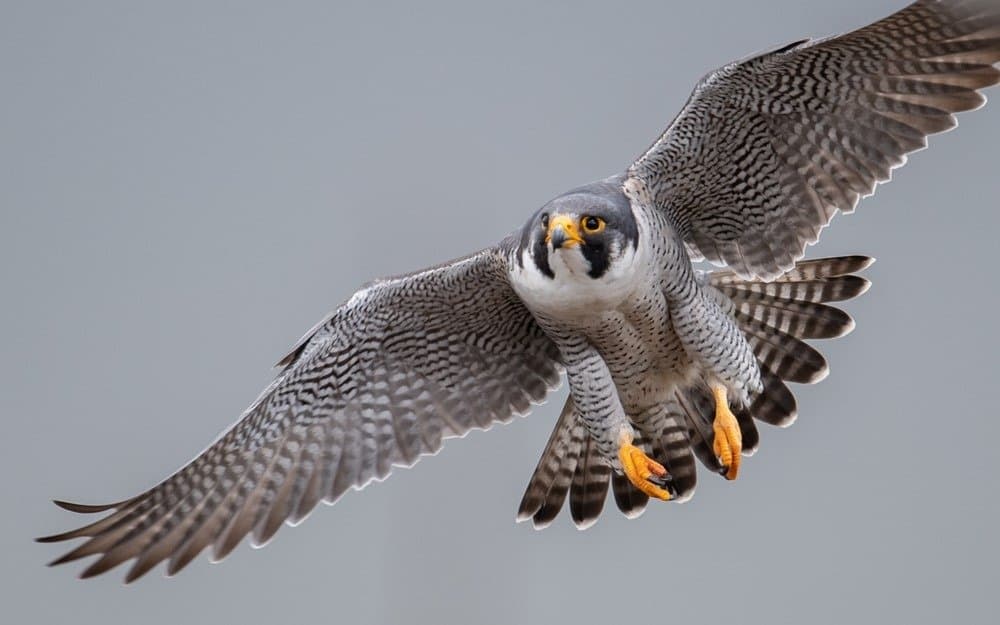
Peregrine falcons have smaller wingspans than ospreys.
©Harry Collins Photography/Shutterstock.com
The peregrine falcon is smaller than the osprey. This size difference helps the falcon hunt extremely fast prey (mostly birds) as the smaller the bird, the more nimble it usually is. The wingspan of a peregrine is between 2.4 and 3.9 feet.
The osprey is a larger bird than the peregrine falcon. Both are great flyers, but the osprey’s diet of fish doesn’t require the same level of maneuverability that falcons do. On average, the wingspan of an osprey is between 4 and 6 feet.
Peregrine Falcon vs Osprey: Distribution
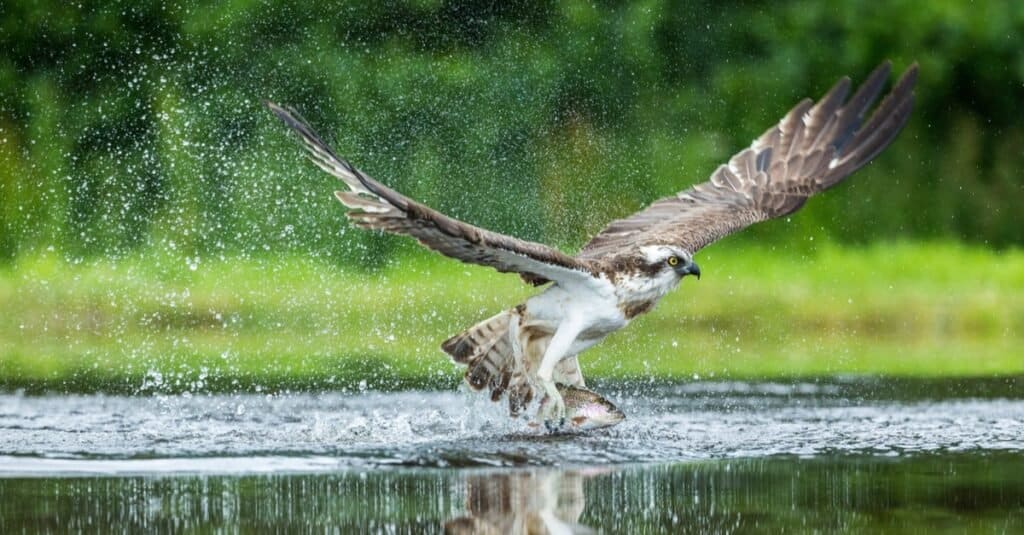
Ospreys are the second most widely distributed raptors in the world.
©LMIMAGES/Shutterstock.com
The battle between the peregrine falcon and the osprey is a close one when it comes to distribution. The peregrine falcon is known as the most widely distributed raptor in the world. There are 19 subspecies spanning every continent besides Antarctica, and they are found in nearly every land region besides extreme polar regions, the highest mountain elevations, and tropical rainforests.
The osprey is a close second and is known as the second most distributed raptor in the world. Like the falcon, it is found on every continent besides Antarctica. The primary ranges for the osprey are across the Americas and in Australasia, with only the Australian populations being non-migratory.
Peregrine Falcon vs Osprey: Top speed

Peregrine falcons are the fastest animals on the planet and can reach 240 mph.
©Harry Collins Photography/Shutterstock.com
The peregrine falcon isn’t just fast; it’s the fastest animal in the world. These birds have widely been touted as the fastest animals on the planet, and the numbers don’t lie. The highest recorded speed was 242 mph and was recorded by National Geographic. It’s important to note, however, that these speeds are only seen during extreme dives from great altitudes, a feat that peregrines are famous for.
Ospreys are fast, but they don’t use insane speed as a large part of their hunting strategy like peregrines do. Most ospreys can reach speeds of around 80 mph, but they could likely go higher if they were inclined to dive as the peregrine does.
Peregrine Falcon vs Osprey: Prey

The peregrine falcon mostly preys on birds.
©TPCImagery – Mike Jackson/Shutterstock.com
Most raptors have varied diets, and peregrines are no exception. Still, they prefer small to medium-sized birds as prey, with some populations having a diet consisting of 80% birds. Peregrines have the most diverse range of birds as prey sources globally, with around 2,000 species being predated by peregrines worldwide. As a supplement to birds, peregrines also prey on mammals and small reptiles.
Ospreys are much more selective when it comes to their prey sources. Other names for the osprey include sea hawk, river hawk, and fish hawk, giving us some clues about the food they prefer. Around 99% of an osprey’s diet is made up of fish, and their biology is specially adapted for it. Their talons have reversed scales and a reversible outer toe for better grip on slippery fish, plus their plumage is oily to shed water when they dive for food.
The photo featured at the top of this post is © Chris Hill/Shutterstock.com
Thank you for reading! Have some feedback for us? Contact the AZ Animals editorial team.







